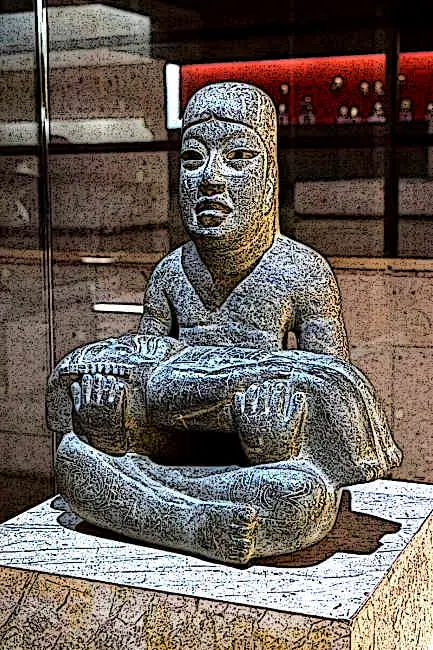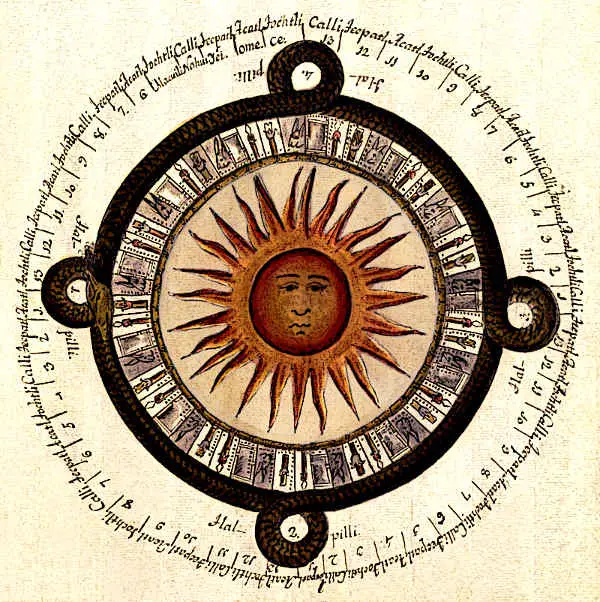The Olmec were the oldest civilization in the Mesoamerican region.
The Olmec prospered in the region from 1400 B.C. to 300 B.C. and they were decisive in the later cultural development of Mayans, Aztecs and other people inhabiting the area.
Olmec culture significantly shaped the later Mayan culture, influencing aspects such as a religion, writing system, cosmology, mythology and mathematics.
Among the most remarkable inventions of the Olmec was a writing system which made use of symbols, a mathematical system which used bars and dots to represent numerical values and a thorough water drainage system which the Olmec used to transport water to their cities.

Olmec are usually credited with the invention of a mathematical system which was to be used later by the Mayans for thousands of years.
This system comprised of two basic symbols, the bar and the dot, which were used to denote numerical values.
The earliest archaeological evidence depicting this mathematical system was found in the epi-Olmec region and dates back to 31 B.C.
In light of this, most researchers believe that the dot-and-bar mathematical system was originally devised by the Olmec and was most popularly used later by the Mayans.
Another remarkable achievement of the Olmec civilization was the development of a writing system.
This was an extraordinary feat since many other civilizations which came into being later, such as the Incas, didn’t have a writing system of their own.
The Olmec writing system has been termed hieroglyphics by the recent researchers, since it is composed entirely of symbols.
The only extant evidence of the Olmec writing system is a stone tablet dated back to 900 B.C.
This tablet contains several symbols which are neatly arrange in a line, in the fashion of the later Mayan hieroglyphs.
Although some researchers dispute this find, most agree that this points to a writing system, especially because of these hieroglyphics’ similarity to the later Mayan glyphs.
Raw rubber as extracted from the rubber tree is not very durable. Olmec had an abundance of rubber trees in the region they inhabited.
They were able to come up with an original method of vulcanizing raw rubber and making it more durable.
To do this, the Olmec treated raw rubber with palm nut smoke. Thanks to their knowledge of vulcanizing rubber, Olmecs were able to create an extensive range of objects using this rubber. These included bottles, shoes and balls made of rubber.
Vulcanized rubber is particularly notable as an Olmec cultural feature because the rubber balls which the Olmec created were then used in ballgames which became a permanent feature of the later Mesoamerican civilizations.
Although Mayans popularly used the Long Count calendar, the oldest evidence for the use of such a calendar system is dated back to the epi-Olmec civilization.
The epi-Olmec civilization rose after the decline of the Olmec in 400 B.C. but it is considered a direct descendant of the original Olmec civilization.
Consequently, the use of a Long Count calendar among the epi-Olmec people is regarded as evidence enough to suggest that such a calendar was originally invented by the Olmecs.
Other cultural traits of the Olmec civilization, such as an agrarian lifestyle, an available mathematical system and a propensity for astronomical knowledge, corroborate this theory.
This Long Count calendar begins on August 13, 3114 B.C. Although some have claimed that the date suggests the actual time when the calendar was created, modern scholarship believes that the date was arbitrarily fixed by an Olmec priest when creating the Long Count.

Olmecs had an agrarian lifestyle and were directly dependent upon annual harvest to sustain their food needs.
Although they lived in a tropical rain-forest environment, annual rainfall was unpredictable. Probably to counter this, Olmec created excellently conceived water drainage systems.
Olmec used the drainage systems to first fill up certain pools located near their settlements. They would then direct the water from these pools to different parts of the city using conduits.
A notable example of such a water drainage system has been discovered near the site of the largest Olmec city, located near modern-day San Lorenzo.
It is worth noting here that the Mayans later used similar reservoirs and conduits of water to store and transport water for their own cities.
One of the most enduring Olmec inventions that has survived as a vital part of the Mesoamerican culture even down to this day, is the ballgame.
The earliest evidence of the sport dates back to 16th century B.C. and evidence from subsequent periods shows that ballgame was a popular sport among the Olmecs.
Olmec created the earliest rubber balls by shaping them around human skulls. These balls were then used by teams of players who tried to hit them through a hoop using their hips and legs.
The sport was closely associated with ritual human sacrifice, so it is believed that it originally came into being as part of the Olmec religious practices.
The religious nature of the ballgame sustained through the later Mayan and Aztec periods.
Olmecs inventions are remarkable for the fact that although not a lot of contemporary evidence for them exists from the Olmec period, they were able to exist in one form or the other through the later Mesoamerican civilizations.
Among the inventions that were transmitted by the Olmec to these later civilizations was a mathematical system using bars and dots, a writing system comprising of hieroglyphic representation and the popular sport of ballgame.
Olmec also constructed water drainage system using stone and were able to create a form of vulcanized rubber which helped them create different durable objects.
Olmec Long Count calendar is one of the most remarkable inventions of the civilization, something which was extensively used by the later Mayan civilization.